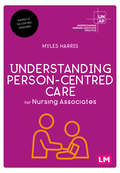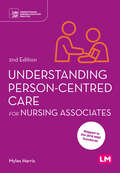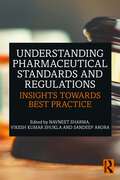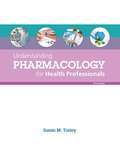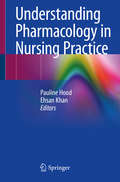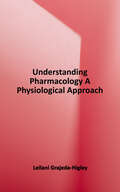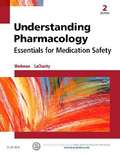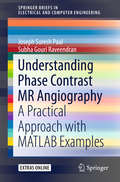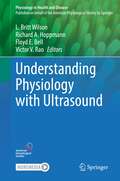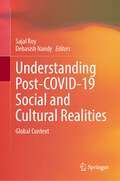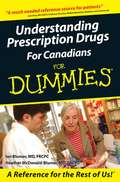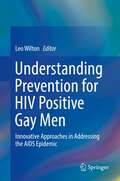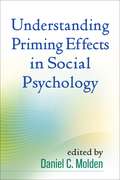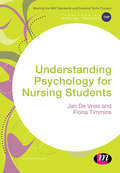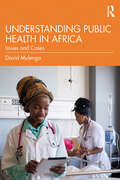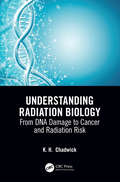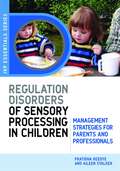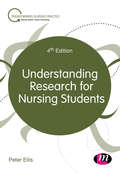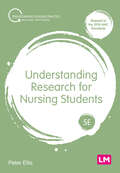- Table View
- List View
Understanding Person-Centred Care for Nursing Associates (Understanding Nursing Associate Practice)
by Myles HarrisUnderstanding how to deliver effective, person-centred care is vital for a future career as a Nursing Associate. In this book, trainee nursing associates are introduced to the principles of person-centred care, with case studies from a variety of healthcare settings and guidance on caring for different patient groups, from acute care to long-term and palliative care. This allows TNAs to see how the theory can be directly applied to their daily practice, regardless of where they work. The book also covers key issues in relation to providing care, such as inclusivity, ethics, legal issues, and health inequalities. Key features: Fully mapped to the new NMC standards of proficiency for nursing associates (2018) Case studies, activities and other learning features help TNAs understand the theory and apply it to practice Designed around a Nursing Associate course, this book demonstrates how person-centred care feeds into each core module. ABOUT THE SERIES: The Understanding Nursing Associate Practice series (UNAP) is a new collection of books uniquely designed to support trainee Nursing Associates throughout their training and into a professional career.
Understanding Person-Centred Care for Nursing Associates (Understanding Nursing Associate Practice)
by Myles HarrisUnderstanding how to deliver effective, person-centred care is vital for a future career as a Nursing Associate. In this book, trainee nursing associates are introduced to the principles of person-centred care, with case studies from a variety of healthcare settings and guidance on caring for different patient groups, from acute care to long-term and palliative care. This allows TNAs to see how the theory can be directly applied to their daily practice, regardless of where they work. The book also covers key issues in relation to providing care, such as inclusivity, ethics, legal issues, and health inequalities. Key features: Fully mapped to the new NMC standards of proficiency for nursing associates (2018) Case studies, activities and other learning features help TNAs understand the theory and apply it to practice Designed around a Nursing Associate course, this book demonstrates how person-centred care feeds into each core module. ABOUT THE SERIES: The Understanding Nursing Associate Practice series (UNAP) is a new collection of books uniquely designed to support trainee Nursing Associates throughout their training and into a professional career.
Understanding Person-Centred Care for Nursing Associates (Understanding Nursing Associate Practice)
by Myles HarrisUnderstanding how to deliver effective, person-centred care is vital for a future career as a Nursing Associate. In this second edition, trainee nursing associates will be introduced to the principles of person-centred care, provided with guidance on caring for a broad range of different patient groups (including acute, long-term and palliative care), and prepared for practice in any healthcare setting via case studies drawn from across the lifespan and nursing fields. Key issues relating to providing care such as inclusivity, health inequalities and ethics are covered, including through new case studies. Key features: Clearly explains the principles and theory underpinning person-centred care to encourage a holistic and evidence-based approach to practice Fully mapped to the NMC standards of proficiency for nursing associates (2018) Case studies and activities drawn from all fields of nursing and across the lifespan illustrate theory in different practice settings Written specifically to address the unique experiences, challenges and requirements of the nursing associate role ABOUT THE SERIES: The Understanding Nursing Associate Practice series (UNAP) is a new collection of books uniquely designed to support trainee nursing associates throughout their training and into a professional career.
Understanding Person-Centred Care for Nursing Associates (Understanding Nursing Associate Practice)
by Myles HarrisUnderstanding how to deliver effective, person-centred care is vital for a future career as a Nursing Associate. In this second edition, trainee nursing associates will be introduced to the principles of person-centred care, provided with guidance on caring for a broad range of different patient groups (including acute, long-term and palliative care), and prepared for practice in any healthcare setting via case studies drawn from across the lifespan and nursing fields. Key issues relating to providing care such as inclusivity, health inequalities and ethics are covered, including through new case studies. Key features: Clearly explains the principles and theory underpinning person-centred care to encourage a holistic and evidence-based approach to practice Fully mapped to the NMC standards of proficiency for nursing associates (2018) Case studies and activities drawn from all fields of nursing and across the lifespan illustrate theory in different practice settings Written specifically to address the unique experiences, challenges and requirements of the nursing associate role ABOUT THE SERIES: The Understanding Nursing Associate Practice series (UNAP) is a new collection of books uniquely designed to support trainee nursing associates throughout their training and into a professional career.
Understanding Pharmaceutical Standards and Regulations: Insights Towards Best Practice
by Sandeep Arora Navneet Sharma Vikesh Kumar ShuklaThis unique resource provides a comprehensive guide to the evolving regulations and standards which govern the international pharmaceutical industry. Featuring clear explanations of the latest regulations, as well as insights and strategies to maintain compliance, the book covers the key principles of best-practice for laboratory research, manufacturing, and distribution. It also offers strategies to navigate the intricacies of different regulatory environments so that pharmaceutical companies can operate internationally, avoiding the potentially costly risk of violations. Detailed and holistic, the book is an essential resource to pharmaceutical researchers and manufacturers, as well as an important resource for students and scholars in the field.
Understanding Pharmacology For Health Professionals
by Susan TurleyUnderstanding Pharmacology for Health Professionals provides a well-organized, easy-to-understand introduction to the world of drugs and pharmaceuticals. The Fifth Edition is structured into three broad, clear units that divide the vast subject of pharmacology into an approachable guide for students and experienced health professionals. Today’s most up-to-date drug information is enhanced with beautiful illustrations and photographs that allow students to delve into the visual world of pharmacology while deeply engaging with the text. A comprehensive drug reference glossary as well as a set of thorough appendices supplements the text to further simplify the extensive array of drug information available. KEY TOPICS: Introduction to Pharmacology and the History of Drugs; Drug Design, Testing, Manufacturing, and Marketing; Drug Forms; Routes of Administration and the Drug Cycle; Using Drugs Therapeutically; The Prescription; Urinary Drugs; Gastrointestinal Drugs; Musculoskeletal Drugs; Respiratory Drugs; Cardiovascular Drugs; Hematologic Drugs; Gynecologic and Obstetric Drugs; Endocrine Drugs; Neurologic Drugs; Psychiatric Drugs; Dermatologic Drugs; Ophthalmic Drugs; Ears, Nose, and Throat Drugs; Analgesic Drugs; Anti-Infective Drugs; Chemotherapy Drugs; Vaccines; Anesthetic Drugs; Emergency Drugs, Intravenous Fluids, and Blood Products. MARKET: Impeccably organized and enjoyable to read, Understanding Pharmacology for Health Professionals makes a broad and difficult subject matter both graspable and interesting for both students and practicing health professionals.
Understanding Pharmacology For Health Professionals
by Susan TurleyUnderstanding Pharmacology for Health Professionals simplifies the vast world of drugs and pharmaceuticals. It groups drug categories by therapeutic effects and the disease they're used to treat, while streamlining drug data through an A-Z Drug Reference and other resources. The fully updated 6th edition has been condensed into a 15-chapter text, to better accommodate a 16-week semester schedule and to let you focus on just one chapter per week. New "see-and-say" drug pronunciations, word part and meaning boxes, and enhanced activities help you engage with and retain the material.
Understanding Pharmacology in Nursing Practice
by Pauline Hood Ehsan KhanThis textbook provides a structured, informed approach to the understanding and appreciation of drug action and effect providing a detailed description and discussion of pharmacokinetics and pharmacodynamics for nurses.The text focuses and emphasizes safe prescribing and administration of medication highlighting the possible harm to patient in terms of adverse reactions.This book also includes the seldom addressed facet of pharmacotherapeutics; drug formulation as applied to practice, and adverse reactions. It informs on the medication used to manage diabetes mellitus, respiratory disease, gastrointestinal tract, the central nervous system and many other affections.Uniting these essential pharmacological processes and applying them to physiological system based medications, this work highlights issues relevant to drug interaction and important nursing responsibilities associated with administration/prescribing. The overall aim of the text is to equip the nurse with an understanding of issues related to pharmacotherapeutics that is aligned to current nursing roles and statutory requirements.
Understanding Pharmacology: A Physiological Approach
by Leilani Grajeda-HigleyAn adjunct text for Nursing Pharmacology courses. This text makes pharmacology more interesting and understandable for nursing students, using a unique concept to look at drugs as chemicals mimicking the molecular “languages” of the body. It emphasizes the idea that cells communicate with one another and that drugs imitate that communication within the body's nervous, endocrine, and immune systems. Clever and fun line drawings make the complex subject matter comprehensible and reinforce the concepts by illustrating drug actions.
Understanding Pharmacology: Essentials For Medication Safety
by Linda LaCharity M. WorkmanPharmacology can be difficult. But with the right text, understanding drugs and how they work doesn’t have to be! Using easy-to-follow language and engaging learning tools ― like Memory Joggers, Clinical Pitfalls, Do Not Confuse, and Drug Alerts ― the second edition of Understanding Pharmacology: Essentials for Medication Safety helps readers really understand how drugs work. In addition to the popular critical thinking activities from the first edition, the second edition also includes more chapter review questions, updated content, and a new organization that centers on the different body systems. For students who have a limited background in the sciences and want complete preparation for licensure exams and clinical practice, there is no better choice than Understanding Pharmacology, 2nd Edition!
Understanding Phase Contrast MR Angiography
by Joseph Suresh Paul Subha Gouri RaveendranProviding many unique MATLAB codes and functions throughout, this book covers the basics of Magnetic Resonance Imaging (MRI), leading to an in-depth understanding of the concepts and tools required for analysis and interpretation of Phase Contrast MR Angiography (PC-MRA). The concept of PC-MRA is often difficult, but essential for practicing engineers and scientists working in MR related areas. The concepts are better understood by uniquely combining the physical principles of fluid flow and MR imaging, laid out by modeling the theory and applications using a commonly used software tool MATLAB®. The book starts with a detailed theory of PC-MRA followed by a description of various image processing methods, including detailed MATLAB codes used for their implementation. The flow concepts in the context of MR imaging are explained using MATLAB based simulations.
Understanding Physiology with Ultrasound (Physiology in Health and Disease)
by Richard A. Hoppmann L. Britt Wilson Floyd E. Bell Victor V. RaoThis book will be of interest to anyone who wants to use ultrasound to understand human physiology both in the clinical setting and the classroom. Tremendous advances in ultrasound technology have resulted in portable ultrasound systems that are easy to use, produce excellent images, and are affordable with quality hand-held and laptop-sized systems costing between $2K and $20K. These systems are now being used at the patient bedside or point of care by almost all medical and surgical specialities from primary care to orthopaedic surgery. These portable systems, especially the hand-held devices, are now being called the stethoscopes of the 21st century and will likely be used by many that are presently using stethoscopes including physicians, nurses, physician assistants, medics and other health professionals. Ultrasound began to be used in medical student education in the 1990s and is steadily becoming a common teaching tool for courses like anatomy and physiology. It is a visual, highly interactive learning tool that bridges the basic and clinical sciences and allows the learner to observe physiology principles in a living model. Ultrasound is also being used to teach other health professions students as well as undergraduate college students and high school students. Despite this interest there are no books available that provide an introduction to ultrasound and how it can be used to enhance the teaching of physiology. This e-book will do just that as well as offer “How to Scan” videos with example laboratory exercises to further engage learners.
Understanding Post-COVID-19 Social and Cultural Realities: Global Context
by Sajal Roy Debasish NandyThis book concentrates on the changing patterns of work and global social order as a result of COVID-19. It scrutinizes these changes in order to point out the possible reasons for these changes following COVID-19. It sheds light on the differences between the condition of underdeveloped and developed countries, focusing on how they struggle to find ways of coping. The pandemic has changed the global social order. It has an impact on every aspect of life around the globe, from individual relationships to institutional operations and international collaborations. Societies are endeavoring to protect themselves despite severe restrictions, while the pandemic continues to upset family relations and overturn governance. COVID-19 has made it clearer than ever before that where many strains on the social sector occur, the current global system, with its interconnectedness and vulnerabilities, is under threat. Due to the changing patterns of economic and societal elements caused by COVID-19, further research is urgently needed to analyze these changing trends. The book portrays what work and the global social order will look like in the future. It is essential reading for anyone interested in these changes and the pst-COVID-19 reality.
Understanding Prescription Drugs For Canadians For Dummies
by Ian Blumer Heather Mcdonald-BlumerThe ultimate Canadian guide to prescription medicationOver half of all Canadians take at least one prescription drug, but most of us know very little about the medication we're taking, including why we've been prescribed anything in the first place. Understanding Prescription Drugs Canadians For Dummies will answer many of the questions Canadians have about prescription drugs, but were afraid ask our doctors and pharmacists. Topics covered include:* What a prescription drug is* Common concerns* Side effects* Ailments and drugs used to treat them* Prescribing practicesUnderstanding Prescription Drugs For Canadians For Dummies will go beyond the encyclopedic and often overwhelming information offered in massive pill books on the Web. It will empower readers, providing them with the knowledge they need as responsible consumers.
Understanding Prevention for HIV Positive Gay Men: Innovative Approaches in Addressing the AIDS Epidemic
by Leo WiltonThis innovative collection offers a wide-ranging palette of psychological, public health, and sociopolitical approaches toward addressing the multi-level prevention needs of gay men living with HIV and AIDS. This book advances our understanding of comprehensive health care, risk and preventive behaviors, sources of mental distress and resilience, treatment adherence, and the experiences of gay men's communities such as communities of color, youth, faith communities, and the house ball community. Interventions span biomedical, behavioral, structural, and technological approaches toward critical goals, including bolstering the immune system, promoting safer sexual practices, reducing HIV-related stigma and discrimination, and eliminating barriers to care. The emphasis throughout these diverse chapters is on evidence-based, client-centered practice, coordination of care, and inclusive, culturally responsive services. Included in the coverage: Comprehensive primary health care for HIV positive gay men From pathology to resiliency: understanding the mental health of HIV positive gay men Emerging and innovative prevention strategies for HIV positive gay men Understanding the developmental and psychosocial needs of HIV positive gay adolescent males Social networks of HIV positive gay men: their role and importance in HIV prevention HIV positive gay men, health care, legal rights, and policy issues Understanding Prevention for HIV Positive Gay Men will interest academics, researchers, prevention experts, practitioners, and policymakers in public health. It will also be important to research organizations, nonprofit organizations, and clinical agencies, as well as graduate programs related to public health, consultation, and advocacy.
Understanding Priming Effects in Social Psychology
by Daniel C. MoldenHow incidentally activated social representations affect subsequent thoughts and behaviors has long interested social psychologists. Recently, such priming effects have provoked debate and skepticism. Originally a special issue of Social Cognition, this book examines the theoretical challenges researchersmust overcome to further advance priming studiesand considers how these challenges can be met. Thevolume aims to reduce the confusion surrounding current discussions by more thoroughly considering the many phenomena in social psychology that the term "priming" encompasses, and closely examining the psychological processes that explain when and how different types of priming effects occur.
Understanding Psychology for Nursing Students (Transforming Nursing Practice)
by Jan De Vries Fiona TimminsDo your students find psychology difficult to engage with or want a textbook that is easy to read? Would they benefit from a textbook that demonstrates how psychology applies to nursing? Right from the start of their programme it is crucial for nursing students to understand the significance of psychology in nursing. This book helps students recognise why they need to know about psychology, how it can affect and influence their individual nursing practice as well as the role it plays in health and illness. Written in clear, easy to follow language and with each chapter linking to relevant NMC Standards and Essentials Skills Clusters it simplifies the key theory and puts the discipline of psychology into context for nursing students, with clear examples and case studies used throughout. Transforming Nursing Practice is a series tailor made for pre-registration student nurses. Each book in the series is: · Affordable · Mapped to the NMC Standards and Essential Skills Clusters · Focused on applying theory to practice · Full of active learning features ‘The set of books is an excellent resource for students. The series is small, easily portable and valuable. I use the whole set on a regular basis.’ - Fiona Davies, Senior Nurse Lecturer, University of Derby
Understanding Public Health in Africa: Issues and Cases
by David MulengaThis innovative textbook, written by an author based in Zambia, provides an invaluable perspective on the key public health issues that Africa is facing today.In addition to outlining the fundamental principles of public health, the book highlights the specific challenges faced in low-resource settings across the continent. It is split into four parts. Part I covers the core concepts of public health, including the different determinants that affect public health, as well as how health systems are organized. Part II looks at environmental factors such as air pollution, water sanitation, and food and nutrition, while Part III focuses on issues around infectious and non-communicable diseases, including chapters on tuberculosis, malaria, HIV/AIDS, maternal health, and mental health. Part IV covers emerging issues affecting public health such as climate change and the effects of mining in the region.With each chapter providing examples and case studies to illustrate the issues, success stories, and innovative approaches being taken in countries such as Tanzania, Uganda, Kenya, Malawi, and Nigeria, this unique book will fascinate students of Public Health, Global Health, African Studies, and beyond.
Understanding Radiation Biology: From DNA Damage to Cancer and Radiation Risk
by Kenneth ChadwickThis book provides a qualitative and quantitative exploration of the action of radiation on living matter which leads to a complete and coherent interpretation of radiation biology. It takes readers from radiation-induced molecular damage in the nucleus of the cell and links this damage to cellular effects such as cell killing, chromosome aberrations and mutations before exploring organ damage, organism lethality and cancer induction. It also deals with radiological protection concepts and the difficulties of predicting the dose–effect relationship for low-dose and dose rate radiation risk. The book ends with separate chapters dealing with the effects of UV light exposure and risk classification of chemical mutagens, both of which are derived by logical extensions of the radiation model. This book will provide the basic foundations of radiation biology for undergraduate and graduate students in medical physics, biomedical engineering, radiological protection, medicine, radiology and radiography. Features: Presents a comprehensive insight into radiation action on living matter; Contains important implications for radiological protection and regulations; Provides analytical methods for applications in radiotherapy.
Understanding Regulation Disorders of Sensory Processing in Children: Management Strategies for Parents and Professionals
by Pratibha Reebye Aileen StalkerChildren with Regulation Disorders of Sensory Processing struggle to regulate their emotions and behaviors in response to sensory stimulation. This book explains how to recognize these disorders, which are often misdiagnosed, and offers practical ways of helping children with regulation disorders. The authors describe the everyday experiences of those who interact with infants and children with Regulation Disorders of Sensory Processing. They explain the distinguishing characteristics, symptoms, diagnosis, assessment and treatment approaches for the disorder. Focusing on early intervention, they present a range of management strategies for sensory sensitivities, motor problems, over- or under-reaction, and extremes of behavior. These practical strategies for parents and professionals will help children with regulation disorders integrate and succeed in the family, at school and in the community. This concise book will be of interest to those who assess, educate and parent children with regulation disorders.
Understanding Research for Nursing Students (Transforming Nursing Practice Series)
by Peter EllisIf you’re learning about research for the first time, or grappling with an essay or final year project, this is the nursing research book you’re looking for. Using plain language and case studies that relate research directly to every-day nursing situations, the author guides you through the central concepts you need to know to truly understand research in nursing. Key features Each chapter is linked to the new NMC standards of proficiency for registered nurses Seven concise chapters that quickly answer the most common questions about research Activities, scenarios and case studies bring the theory to life and show why research is so important to nursing Nine podcasts to bring topics from the book to life
Understanding Research for Nursing Students (Transforming Nursing Practice Series)
by Peter EllisIf you’re learning about research for the first time, or grappling with an essay or final year project, this is the nursing research book you’re looking for. Using plain language and case studies that relate research directly to every-day nursing situations, the author guides you through the central concepts you need to know to truly understand research in nursing. Key features Each chapter is linked to the new NMC standards of proficiency for registered nurses Seven concise chapters that quickly answer the most common questions about research Activities, scenarios and case studies bring the theory to life and show why research is so important to nursing Nine podcasts to bring topics from the book to life
Understanding Research for Nursing Students (Transforming Nursing Practice Series)
by Peter EllisGet to grips with all aspects of research that you need to succeed in your nursing degree. Learn why research is so important to nursing, develop your knowledge of key methods and terminology and build your confidence in applying research principles to your nursing practice. Key features o Each chapter is mapped to the 2018 NMC standards, showing how research relates to the requirements of a registered nurse o Straightforward language and a step-by-step approach introduce you to key concepts and guide you through all aspects of the research process o Filled with activities and case studies to help you apply research principles and methods to your studies and practice
Understanding Research for Nursing Students (Transforming Nursing Practice Series)
by Peter EllisGet to grips with all aspects of research that you need to succeed in your nursing degree. Learn why research is so important to nursing, develop your knowledge of key methods and terminology and build your confidence in applying research principles to your nursing practice. Key features o Each chapter is mapped to the 2018 NMC standards, showing how research relates to the requirements of a registered nurse o Straightforward language and a step-by-step approach introduce you to key concepts and guide you through all aspects of the research process o Filled with activities and case studies to help you apply research principles and methods to your studies and practice
Understanding Research for Nursing Students (Transforming Nursing Practice Series)
by Peter EllisGet to grips with all aspects of research that you need to succeed in your nursing degree. Learn why research is so important to nursing, develop your knowledge of key methods and terminology and build your confidence in applying research principles to your nursing practice. Key features • Each chapter is mapped to the 2018 NMC standards, showing how research relates to the requirements of a registered nurse • Includes new case studies drawn from real life research and expanded discussions of research ethics and participant support • Uses straightforward language and a step-by-step approach to introduce you to key concepts and guide you through all aspects of the research process • Filled with activities and case studies to help you apply research principles and methods to your studies and real-world practice
